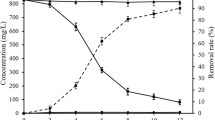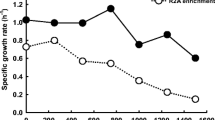Abstract
A lead resistant fungus was isolated from the Pacific sediment. It was associated with Penicillium according to its partial sequences of 18S and ITS. The fungus could grow in the presence of 24 mM Pb(NO3)2 in a liquid medium, and no growth inhibition was observed at 4 mM and below. When growing in the presence of 4 mM Pb(NO3)2, the fungus accumulated a large amount of lead granules in the cell, as well as adsorbed on the outer layer of cell wall, as observed under a transmission electron microscope. The intracellular lead deposited either in the vicinity of the cytoplasm membrane or in the vacuoles, and also could aggregate into large particles in the cytoplasm. However, lead was not adsorbed on the thick inner wall of the fungus. Energy dispersive X-ray spectroscopy analysis showed that these granules or particles mainly consisted of lead, and other elements could hardly be detected. Selected area electron diffraction analysis showed that there were regular crystalline lattices in the lead precipitates, indicating that they were actually in the form of crystals to some extent. Therefore, both intracellular bioaccumulation and extracellular biosorption had contributed to the high resistance of this fungus to lead. These results suggest that this fungus can be used in biotreatment as a lead trapper.



Similar content being viewed by others
References
Bååth E (1989) Effects of heavy metals in soil on microbial processes and populations (a review). Water Air Soil Pollut 47:335–379
Baldrian P (2003) Interactions of heavy metals with white-rot fungi. Enzyme Microb Technol 32:78–91
Bhaskar PV, Bhosle NB (2006) Bacterial extracellular polymeric substance (EPS): a carrier of heavy metals in the marine food-chain. Environ Int 32(2):191–198
Borremans B, Hobman JL, Provoost A, Brown NL, van Der Lelie D (2001) Cloning and functional analysis of the pbr lead resistance determinant of Ralstonia metallidurans CH34. J Bacteriol 183:551–568
Bruins MR, Kapil S, Oehme1 FW (2000) Microbial resistance to metals in the environment. Ecotoxicol Environ Saf 45:198–207
Diels L, Sadouk A, Mergeay M (1989) Large plasmids governing multiple resistance to heavy metals: a genetic approach. Toxicol Environ Chem 23:79–89
Donmez G, Aksu Z (1999) The effect of copper (II) ions on the growth and bioaccumulation properties of some yeasts. Process Biochem 35:135–142
Dursun AY, Ulsu G, Cuci Y, Aksu Z (2003) Bioaccumulation of copper(II), lead(II) and chromium(VI) by growing Aspergillus niger. Process Biochem 38(10):1647–1651
Gadd GM (1993) Interactions of fungi with toxic metals. New Phytol 124:25–60
Hasnain S, Yasmin S, Yasmin A (1993) The effects of lead-resistant Pseudomonads on the growth of Triticum aestivum seedlings under lead stress. Environ Pollut 81:179–184
Levinson HS, Mahler I (1998) Phosphatase activity and lead resistance in Citrobacter freundii and Staphylococcus aureus. FEMS Microbiol Lett 161:135–138
Levinson HS, Mahler I, Blackwelder P, Hood T (1996) Lead resistance and sensitivity in Staphylococcus aureus. FEMS Microbiol Lett 145:421–425
Malik A (2004) Metal bioremediation through growing cells. Environ Int 30:261–278
Mergeay M, Monchy S, Vallaeys T, Auquier V, Benotmane A, Bertin P, Taghavi S, Dunn J, van der Lelie D, Wattiez R (2003) Ralstonia metallidurans, a bacterium specially adapted to toxic metals: towards a catalogue of metal-responsive genes. FEMS Microbiol Rev 27:385–410
Ngu M, Moya E, Magan N (1998) Tolerance and uptake of cadmium, arsenic and lead by Fusarium pathogens of cereals. Int Biodeterior Biodegradation 42:55–62
Roane TM (1999) Lead resistance in two bacterial isolates from heavy metal-contaminated soils. Microb Ecol 37:218–224
Shao Z, Sun F (2007) Intracellular sequestration of manganese and phosphorus in a metal-resistant fungus Cladosporium cladosporioides from deep sea sediment. Extremophile (published online)
Taboski M, Rand T, Piórko A (2005) Lead and cadmium uptake in the marine fungi Corollospora lacera and Monodictys pelagica. FEMS Microbiol Ecol 53(3):445–453
Trajanovska S, Britz ML, Bhave M (1997) Detection of heavy metal ion resistance genes in gram-positive and gram-negative bacteria isolated from a lead-contaminated site. Biodegradation 8:113–124
Zanardini E, Andreoni V, Borin S, Cappitelli F, Daffonchio D, Talotta P, Sorlini C, Ranallib G, Bruni S, Cariati F (1997) Lead-resistant microorganisms from red stains of marble of the Certosa of Pavia, Italy and use of nucleic acid-based techniques for their detection. Int Biodeterior Biodegradation 40:71–182
Zucconi L, Ripa C, Alianiello F, Benedetti A, Onofri S (2003) Lead resistance, sorption and accumulation in a Paecilomyces lilacinus strain. Biol Fertil Soils 37:17–22
Acknowledgements
This work was supported by the COMRA program (No. DYXM115-02-2), the National Basic Research Program of China (No.2004CB719601) and the National Infrastructure of Natural Resources for Science and Technology Program of China (No. 2005DKA21209).
Author information
Authors and Affiliations
Corresponding author
Additional information
Communicated by A. Driessen.
Rights and permissions
About this article
Cite this article
Sun, F., Shao, Z. Biosorption and bioaccumulation of lead by Penicillium sp. Psf-2 isolated from the deep sea sediment of the Pacific Ocean. Extremophiles 11, 853–858 (2007). https://doi.org/10.1007/s00792-007-0097-7
Received:
Accepted:
Published:
Issue Date:
DOI: https://doi.org/10.1007/s00792-007-0097-7




